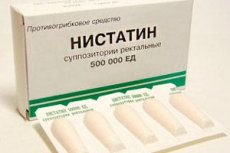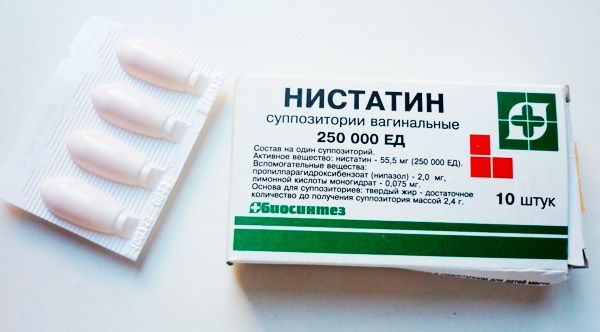Medical expert of the article
New publications
Preparations
Nystatin suppositories in pregnancy
Last reviewed: 04.07.2025

All iLive content is medically reviewed or fact checked to ensure as much factual accuracy as possible.
We have strict sourcing guidelines and only link to reputable media sites, academic research institutions and, whenever possible, medically peer reviewed studies. Note that the numbers in parentheses ([1], [2], etc.) are clickable links to these studies.
If you feel that any of our content is inaccurate, out-of-date, or otherwise questionable, please select it and press Ctrl + Enter.

Nystatin suppositories during pregnancy used to be quite widely used, but given the progress in medicine and the pharmaceutical industry, views on the use of any medications during pregnancy have changed significantly. At the moment, there is no clear data that would indicate the benefits or harm of nystatin during pregnancy, so opinions on the treatment of pregnant women with nystatin are very diverse. There is an opinion that this drug can be used without harm to the child, but we should also not forget that any drug can affect the fetus. Therefore, it is necessary to understand the pharmacological properties of the drug and find out all the pros and cons regarding this drug.
The main pharmacological properties of suppositories with nystatin
Suppositories with nystatin are a drug that has an antifungal effect, which is especially pronounced against yeast-like fungi. The drug is from the group of polyene drugs, which has a pronounced effect on fungi and does not affect bacterial and viral flora. In moderate therapeutic doses, the effect of the drug is to temporarily block the reproduction of fungi, that is, it has a fungistatic effect. When increasing doses to large ones, the drug can also have a fungicidal effect, that is, it kills fungi.
The mechanism of action of suppositories with nystatin is the destruction of the cell membrane of the fungus. This occurs due to the fact that the nystatin molecule has many substances that are similar to the sphere of substances in the membrane of the fungus, and nystatin is built into its membrane, thereby disrupting the work of cellular pumps. As a result of these processes, the normal ionic composition of cellular and extracellular structures is disrupted, which promotes the penetration of sodium ions into the cell, and then water. In this case, the cell disrupts its work and lysis of cellular structures occurs, and then the fungus dies, which stops the reproduction of the fungus.
Pharmacokinetic properties of the drug
Nystatin has special properties, which consist of its very low bioavailability, which reaches no more than three to five percent. Due to this property, the drug, in case of its oral administration, is not absorbed in the intestinal mucosa and does not affect the systemic circulation, it is also taken regardless of food intake. The drug has only a local effect on the fungus, is excreted unchanged with feces. As for local forms, the ointment is not absorbed into the vessels of the subcutaneous tissue when applied.

Suppositories with nystatin have only a pronounced local effect, are not absorbed into the systemic bloodstream. This allows us to assume the possible use of suppositories with nystatin during pregnancy.
Features of the use of suppositories with nystatin
Suppositories with nystatin are used vaginally or rectally. Before taking it is necessary to wash the genitals. Use one suppository twice a day - in the morning and in the evening, inserting the suppositories deep into the vagina. The duration of treatment is not less than ten to fourteen days.
Overdose when using suppositories with nystatin is rare, which is due to the fact that the drug is not absorbed. There may be a slight local manifestation.
Interaction with other drugs consists in reducing their effectiveness in case of simultaneous use with other antifungal or hormonal drugs. Also, the drug is incompatible with other acids, hydrogen peroxide, potassium permanganate.
Storage conditions for candles are as follows: shelf life is two years. Store at a relative temperature of no more than 28 degrees, avoiding direct exposure to high and low temperatures, and also exclude high humidity.
Suppositories with nystatin for thrush during pregnancy have a high potential for use, which is due to their local action and high fungistatic effect. The pharmacokinetic features of the drug allow it to be used due to the fact that it is not absorbed into the systemic bloodstream and acts only on fungi. The issue of harm to the child remains incompletely studied, therefore the drug is not recommended in the first trimester of pregnancy, when the process of organogenesis and differentiation of fetal tissues is intensive.
Suppositories with nystatin during pregnancy are used for candidiasis, which is a direct indication for the prescription of this drug. Given the low bioavailability of the drug, its low toxicity and minor effect on systemic blood flow, we can talk about taking the drug during pregnancy. But each case is individual and the question of the correct prescription of the drug during pregnancy should be decided by the doctor, taking into account all the nuances and features. In any case, the negative effect of suppositories with nystatin on the development of the fetus is not excluded. You need to be attentive to your health and the health of the future child.
 [ 7 ]
[ 7 ]
Basic principles of using nystatin during pregnancy
Pregnancy is a period in a woman's life when all internal organs adapt to the development of the fetus and its vital functions. The development of the fetus occurs gradually and goes through various stages - first, the process of organogenesis occurs, which begins in the first trimester, and then the growth and differentiation of the child's tissues continues. But that's not all, because for normal functioning in the mother's body, normal blood flow and nutrition are necessary, which occurs due to the functioning of the placenta. All these components have a continuous connection with the mother's body, and many processes in the woman's body do not proceed as usual. The fetus is an agent foreign to the woman's body, because it contains 50% of information from the father. The woman's immune system perceives it as an antibody to some extent, therefore, until the formation of its placenta with an individual barrier and blood flow, a state of relative immunosuppression develops. This condition contributes to the development and reproduction of opportunistic flora.
The intestines and vagina are a place that has its own biocenosis and functions normally due to opportunistic microflora. When a woman's overall immunity decreases, local defenses also decrease, which contributes to a decrease in the activity of beneficial microorganisms with the proliferation of pathogenic ones. This is how one of the common diseases that worries pregnant women develops - fungal vaginitis, or thrush. This is a pathology that is characterized by the proliferation of fungal flora of the vagina with the development of corresponding clinical manifestations. This occurs against the background of a decrease in the number of vaginal lactobacilli and Doderlein bacilli, which normally form lactic acid in the vagina when breaking down glucose and thus help maintain a slightly acidic vaginal environment. This is one of the main local mechanisms of vaginal defense, which is impaired in pregnant women with candidiasis or fungal vaginitis.
The drug nystatin in the form of suppositories used to be the "gold standard" for treating candidiasis, but over time the standards were revised due to the formation of fungal resistance to this drug. Today, they are returning to it because microorganisms have "forgotten" this drug a little and it is highly effective. As for pregnant women, the issue of use is very controversial, since special attention is paid to the benefit or possible harm to the fetus. It is very difficult to give a clear answer to the question of using suppositories with nystatin during pregnancy, which is associated with the complex pharmacodynamics of the drug, but this drug is used.
Indications for the use of nystatin suppositories during pregnancy are limited due to the high risk, but the main indication is vaginal candidiasis with the identification of yeast fungi. At the same time, nystatin suppositories are most indicated due to their direct action directly on fungi.
Nystatin, as a pharmacological drug, is available in different forms - in tablets, ointments, suppositories, and is also included in combination drugs. Suppositories, that is, candles, are distinguished as vaginal and rectal, which are used respectively to treat vaginal and intestinal candidiasis. Tablets, ointments and candles have a similar trade name - "Nystatin", and the drug is also included in combination candles for the treatment of candidiasis with the name of the drug " Polygynax ". There are other names for candles with nystatin - "Nystafungin", "Anticandin", "Moronal", "Fungicidin", "Mycostatin", "Stamiin", "Fungistatin".
Contraindications for use and features of side effects
The drug is contraindicated for use, especially during pregnancy, if there is a history of allergic reactions or allergies to additional components of the drug. Some pharmacological studies indicate that the drug is contraindicated during pregnancy and lactation, but this is a very controversial and individual issue, so it cannot be said that it is categorically contraindicated.
Side effects are very rare precisely because of the peculiarities of pharmacodynamics, since the drug is not absorbed and does not affect systemic organs. If the dose is exceeded, dyspeptic disorders may be observed in the form of abdominal pain, nausea, malaise, vomiting. There may be local manifestations when using suppositories with nystatin in the form of itching, discomfort in the vagina, burning.
Attention!
To simplify the perception of information, this instruction for use of the drug "Nystatin suppositories in pregnancy" translated and presented in a special form on the basis of the official instructions for medical use of the drug. Before use read the annotation that came directly to medicines.
Description provided for informational purposes and is not a guide to self-healing. The need for this drug, the purpose of the treatment regimen, methods and dose of the drug is determined solely by the attending physician. Self-medication is dangerous for your health.

